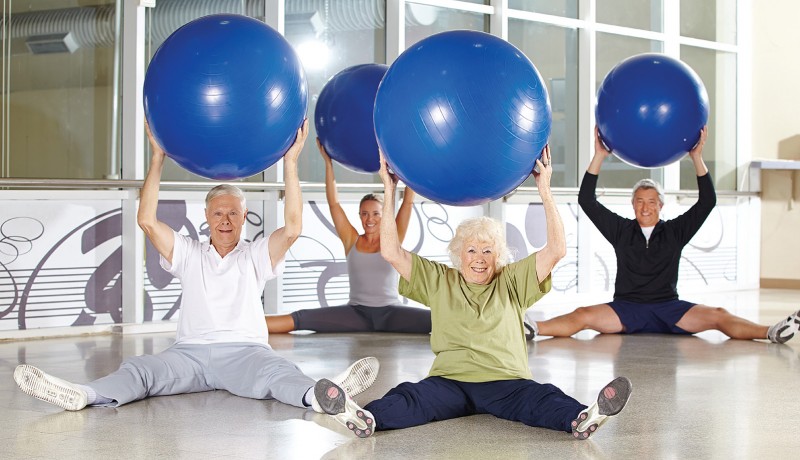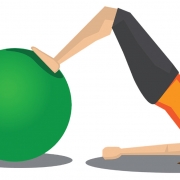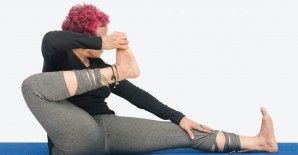
Columns

Shameem Akthar illustrates how a gym ball can be used to intensify your practice
Some props help you enter a new pose and give you support. Other props help you intensify it. So the trick is to know what prop to use and the intention of use—to get over physical or emotional inhibition, or to deepen an already strong practice. So, in this latter category, the gym ball fits the bill perfectly. It is also called the stability ball for that reason, because it requires you to stabilise your body when you use it, and the challenge of maintaining the balance is so demanding that it loads the demand on your muscles enough to deepen the challenge and tone you up further. All balancing acts require intense engagement from the mind too; so, therefore, it can be meditative in a dynamic fashion.
The first reason, of course, is a strong one: to get over your inhibitions in a pose or develop and prepare your muscles for the pose, such as the wheel pose (chakrasana). Ideally, when you use a gym ball on your own, you need to ensure there is somebody to help hold the ball in place or use a wall or block to prevent it from rolling off. Even though it looks like a fun prop, it can be an extremely tricky one to use and a fall from it can be disconcerting. Here, we are showing you a simple and safe pose that may be attempted with the gym ball. It is the shoulder pose (kandharasana) and referred to more popularly as the pelvic tilt.
YOGIC MOVES
Pelvic tilt (kandharasana)
Stabilise the gym ball by placing it firmly against a wall or strong, immovable furniture like a long sofa. Lie down as shown, with legs bent at the knees, feet close to the ball. Lift both feet and place them firmly on the ball. You may need to keep both feet apart to increase control. Your arms should be along the body, palms firm and flat on the ground. Hoist your hips high, inhaling. Exhaling, drop the hips down. Do this a few times and increase the challenge by increasing the number of repetitions, or by holding the pose longer. Benefits: This pose exerts a more intense challenge on the calf and hip muscles, thus toning and shaping them further. Other benefits are the same as in the basic pose: an immune boost, resolution of lower back problems, control of cardiovascular and blood pressure issues, strengthening the uro-genital system and working on the thyroid gland.
KREEDA YOGA
Draksha spardha (grape race)
As this involves a race, choose a space where people can walk/run (depending on the ability of participants). At one end of the space, hang several bunches of grapes (according to the number of participants). They should be at a height where the participants can reach them with their mouth. Lightly, tie the hands of the participants behind their back with a scarf or kerchief. When the race is announced, the lined-up participants should cover the space fast, run to their respective bunches and, without using the hands, eat up as much as possible and race back. The winner is the one who finishes first. You can also hang other edible stuff like a biscuit or anything that allows itself to be hung and eaten without too much chewing or biting. Remember not to keep too much of the edible stuff, though, because participants may get excited and forget to swallow! (Ensure there is no such danger by suggesting that the participants display that they are chewing the food and not keeping it in their mouths.) This game builds speed, impulse control and mental and physical agility.
Shameem Akthar is a Mumbai-based yoga acharya. If you have any queries for her, mail us or email at contact.us@harmonyindia.org. (Please consult your physician before following the advice given here)
Photos: 123RF.com Featured in Harmony — Celebrate Age Magazine April 2017
you may also like to read
-
Mental workout
Mukul Sharma tells you how to keep those grey cells ticking Everyone will ultimately lose his or her brain….
-
Helpline
Dr Harshbir Rana answers your queries on personal and social issues related to ageing, elder care and intergenerational relationships ….
-
Off the cuff
Raju Mukherji pays tribute to his first hero, Tenzing Norgay, an exemplary mountaineer Darjeeling, 1955. Dr ‘Pahari’ Guha Mazumdar….
-
Yoga RX
Shameem Akthar shows ways to control debilitating ankle pain through regular practice Ankle pain is so common and prevalent….








